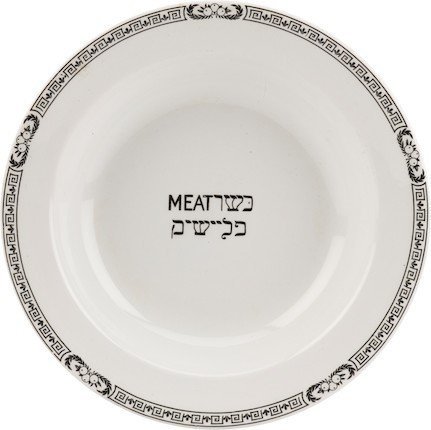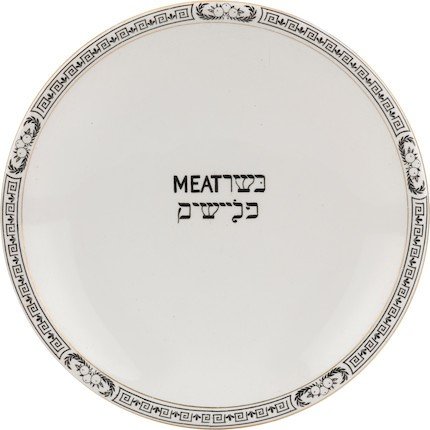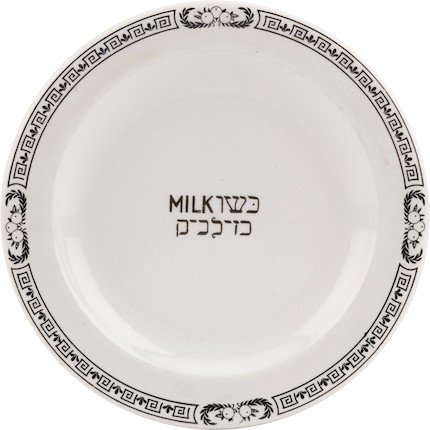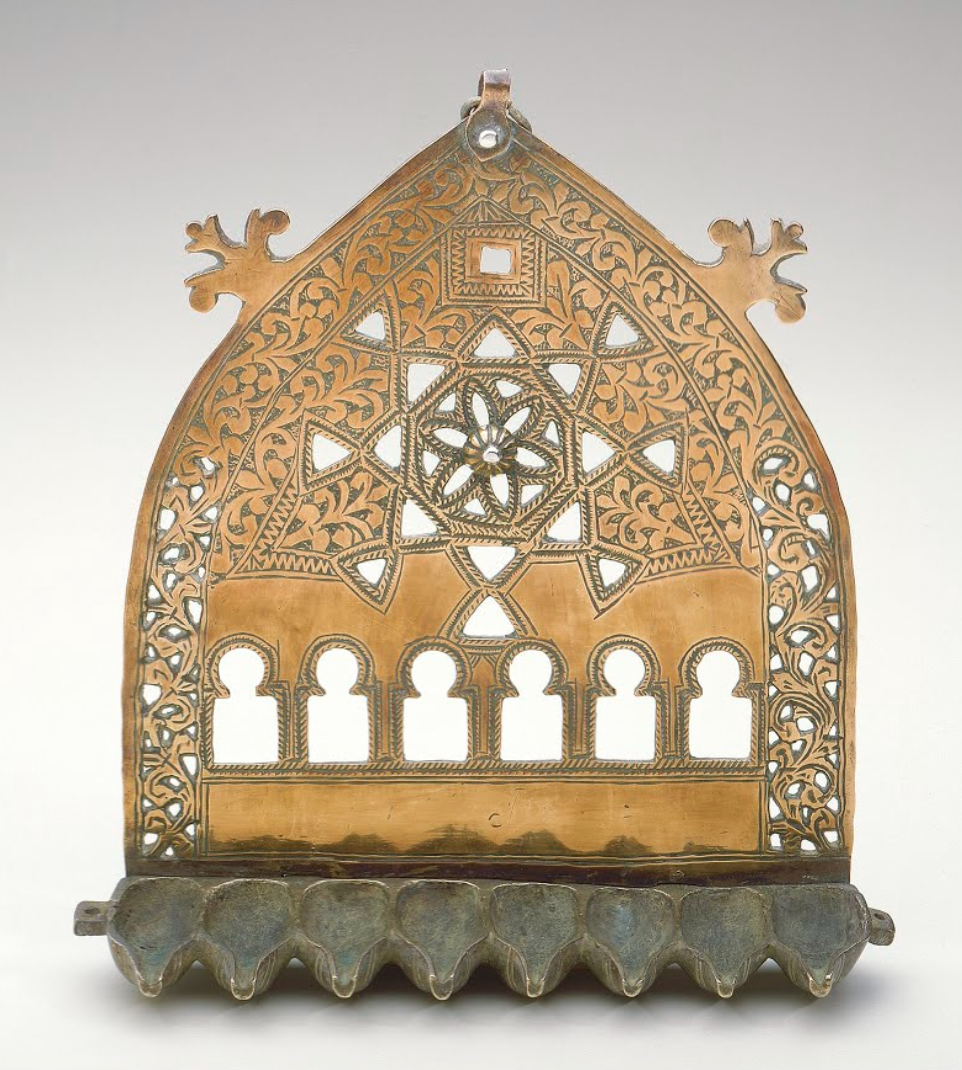Heritage and Judaica: Why Judaica Is Not Exclusively Jewish Art—The Appraisal Dilemma
Editorial Note:
We are delighted to share this article by the appraiser and scholar Dr. Rachael Goldman, AAA, who is an expert in appraising Judaica.
I. What is the difference between Jewish Art and Judaica?
The author at Bonhams, image courtesy of and copyright Dr. Rachael Goldman
The word "Judaica" elicits misty-eyed feelings and nostalgia. The public loves to find additional meaning through Judaica because of the complex history of the Jewish people and creating romanticism of the field. There is also a tendency to overestimate an object's religious significance, usage, and appearance. When Judaica is presented it is often misunderstood, and the name Marc Chagall often comes up. Judaica, Jewish Ceremonial Art, and Israeli Art and Jewish Art all derive from the same origin, but it is their form and function that is different. It is the appraiser's job to demystify the process of appraising Judaica to arrive at substantial facts about where it is from, what stylistic period it belongs to, its maker, and ultimately its function. Trying to research more information about a Purim grogger, Chanukkiyah or even a Shabbat challah cover is problematic because the information may not be accurate or may be attributed to an entirely different family with the same name. The problem that occurs in the appraisal and valuation of Judaica is when more sentimentality is attached to an object. This article will consider the fine details that differentiate Judaica from Jewish Art.
Spice Container, Silver: repoussé, cast, chased, and pierced, Poland, 1881, 8 5/8 × 3 3/4 × 3 7/8 in. (21.9 × 9.5 × 9.8 cm), The Jewish Museum, Credit Line: Gift of Dr. Harry G. Friedman, Accession Number: F 401, Public Domain Image
The appraiser also needs to determine the difference between Judaica designed for the synagogue, collectibles, home decor, and items made for the tourist trade. While there is a great deal of overlap, identifying and explaining the difference among these items is important for the appraiser and impacts how they write their report and market analysis. Judaica and religious items that are used in the synagogue include items such as the Torah and Etz Hayim (rollers for the Torah scroll), Megillah, Parochet (Ark curtain) Keter Torah (Torah crown), Shtender (a piece of liturgical furniture), Yad (Torah pointer in the shape of a hand), Tas (Torah Breastplate), and Rimmonim (Hebrew for pomegranate, applied to a Torah finial). These images may be part of a private collection and can be appreciated at a home. But they are more likely to be found in a synagogue. A rare example of a wooden-encased Torah from Greece can be found in a private collection.[1] However, items that are found in a private collection may not be found in a synagogue, although an appraiser can expect to find the mezuzot, materials for Shabbat, Havdalah compendium, and Passover seder plate.
Woodcarvings from Synagogues, Parochet and Torah Mappah, image courtesy of and copyright Dr. Rachael Goldman
There is a fine distinction between Judaica and Jewish Art. Jewish Art is the academic and scholarly terminology for the cultural, geographic, and religious category for the study of the Jewish people. Judaica is the collector's term for the material that is produced and part of the consumption culture. Both of the terms are rooted in connoisseurship. Some items in Jewish Art may never be available on the marketplace for purchase.
Judaica seen through the eyes of the appraiser becomes more about the purpose, the place, and context and less about how old the object is. In short, an appraiser of Judaica can divorce an object from its legend, myth, and story and instead make a solid case for its value. When an appraiser comes to a home dwelling with Judaica, they will encounter a cycle of life pieces from a myriad of items descended from relatives and extended family. Usually, a kiddush cup from the Bar-mitzvah of a family member is proudly shared.
Kiddush Cup Set, Unknown Artist/Maker, 20th century, Iran, chased and punched silver, Height: 5 5/16 in. (13.5 cm) Diam: 3 5/16 in. (8.4 cm), Credit Line: Gift of Mena Rokhsar in memory of Ebrahim Khalil Rokhsar, Jewish Museum Accession Number: 1993-243a-d, Public Domain Image, full catalog record at https://thejewishmuseum.org/collection/3917
““Objects from Judaica parallel the items in other major fields such as American and European Paintings, Silver, Ceramics, and Glass. An appraiser can place the object in valuation and context based on the parallel field and geographical location where the art was created. Some pieces of furniture and synagogue building components were constructed by well-known firms and could easily be mistaken for their American or European counterparts.””
An appraiser need not be Jewish to understand or appreciate Judaica. But a comprehensive knowledge of Hebrew and Yiddish combined with other European languages is preferred since a lot of items contain inscriptions - although many of the inscriptions are simply references to the holidays or events in Hebrew. A skilled appraiser can recognize the materials and techniques specific to Judaica. Generally, appraisers are questioned about "what are quintessential items of Judaica?" It is not possible to determine exactly which pieces are used most frequently. Instead, there are mainstay items that one can expect to find in a private collection, synagogue, or museum. The items used for the holiday season and specific rituals are the items that are examined and sought out. Objects from Judaica parallel the items in other major fields such as American and European Paintings, Silver, Ceramics, and Glass. An appraiser can place the object in valuation and context based on the parallel field and geographical location where the art was created. Some pieces of furniture and synagogue building components were constructed by well-known firms and could easily be mistaken for their American or European counterparts. One example that is typical of this exchange is the Tzedakah box for the Copenhagen Society for the care of the Sick produced by Mogens Ballin in 1901 during the Jugendstil.[2] Some items are also reflective of the geographical location and culture that the Jewish population lived and thrived under. For example, the Rimmonim that can be viewed here are shaped like Pagodas from China and were made in 1893.[3]
Tzedakah box for the Copenhagen Society for the Care of the Sick, Siegfried Wagner (Danish, 1874–1952); Manufacturer: Mogens Ballin Workshop, Denmark, 1901, pewter, Minneapolis Institute of Art, The Eloise and Elliot Kaplan Endowment for Judaica, 2006.67.2a,b, No known image copyright, full catalog record available at https://collections.artsmia.org/art/101066/tzedakah-box-for-the-copenhagen-society-for-the-care-of-the-sick-siegfried-wagner
Jewish history and Judaica, especially ritual items, have a degree of timelessness associated with them, implying that articles are indeterminate and cannot be dated or assigned a geographical origin. That is an incorrect assumption. In fact, these items can be dated accurately and are assigned a date based on comparable examples. Therefore a lot of Jewish ritual and religious articles may appear older than they really are. An appraiser can see through that veil.
Many pieces of Judaica began their existence as other examples of American or European artwork and then changed to become and used as Tzedakah boxes or ethrog containers. They were originally a sugar or tea canister or a snuff box. The appraiser uses these points as a way of establishing a value and a market analysis.
Part of finding and identifying parts of Judaica and ritual articles includes using existing resources, especially published photographs in inventory records, auction catalogs, and pre-WWI and WII museum catalogs. As an appraiser, I have used magnifying glasses and lenses to get detailed images in faded and blurry pictures and photographs. These often help determine what I am looking at. The appraiser can compare what they see in these catalogs and museum collections to establish exact or near-comparable examples. Old Judaica auction catalogs such as the Mira Salomon collection provide vivid details of pieces that are difficult to identify and rarely appear on the marketplace.[4] Sotheby's, Parke-Bernet, and Christie's auction catalogs from the 1970s through the 1990s yield tons of information, especially as they are in print form. They also provide essential information about cataloging and describing the works.
II. Where can you expect to find Judaica?
Marriage Contract (Kettubah), Tétouan, Morocco, 1837, Ink and gouache on parchment, 17 3/16 × 12 in. (43.7 × 30.5 cm), Credit Line: Gift of Barbara and Benjamin Zucker Family in honor of Daniel M. Friedenberg, Jewish Museum Accession Number: 2008-204, Public Domain Image, full catalog record accessible at https://thejewishmuseum.org/collection/31280
Like many other fields, Judaica and religious objects can be found anywhere. Sometimes items included in the contents are acquired innocently as they belonged to someone else. Some ways that these items are acquired is through the tourist trade, which actually began during the early 20th century and in the Post-War era. This is noted by the ways the items are stamped and marked. But Judaica is found in synagogues, museums, and homes of collectors. Sometimes people who appreciate Judaica will often have a single piece and want to know what its function. Prospective collectors even spotted Judaica at thrift stores such as Goodwill and the Salvation Army; getting great bargains on Israeliana metalware and synagogue woodcarvings. It's always important to keep your eyes open. Often the giveaway on such pieces is the Hebrew lettering.
III. Just because it survived WWII era does not make it more valuable
Though Jewish people do not want the lacrimosity of history to be the sole narrative, and Jewish history does not begin in the 20th century, Holocaust-era materials are vitally important to the narrative and have values associated.
Generally, it is frowned upon when Holocaust-era and World War II values are assessed. In the last 25 years, considerable attention has been devoted to provenance issues. But with the growing creation of Holocaust Memorial Museums and World War II-era institutions wanting to collect these materials, eager donors will be the basis for donating these materials to the institutions. Therefore a Fair Market Value is often required for these donations.
In this particular instance, the category of historical, World War II-Holocaust-era material is interchangeable among the larger categories. Having a history through this period of time does not contribute to a higher value unless it is in exceptional condition and rarity. The archive and ephemera market is broad and varied, with each particular area having its own characteristics and specialists. The large population of Jewish people and the dwindling population of Holocaust survivors contribute to the marketplace for auction houses in Israel. Children and descendants need to part with these materials and it seems like the appropriate avenue to disseminate this material. Museums and historical institutions are not always in need of similar material. Museums and historical institutions can only collect so many armbands and yellow stars. The marketplace is not yet saturated with this type of material, but specialists are still overly cautious about selling them. The internet has also played an important role, for better or worse, on this subject. The concern is always that the material might end up in the wrong hands. In fact, The Katz Ehrenthal Collection was owned by Peter Ehrenthal, a Romanian Holocaust Survivor was a prolific collector of Anti-semitica, which was donated to the United States Holocaust Memorial Museum in 2016. It is a complete and encyclopedic collection of any conceivable example of Anti-semitic items.
What are the influences on the marketplace? Oftentimes these archives are collected by accident by Holocaust Survivors and their family. Rarity and condition are the most important qualifying considerations. For example, on the Antiques Roadshow, October 6, 2021, Ken Gloss appraised an archive dated circa 1942-1945, of Holocaust Survivor items including two photographs, a postcard sent from the labor camp Ober Alstadt, a subcamp of Gross Rosen in Czechoslovakia, and a handmade shirt made in the labor camp.[5] Gloss addressed the issues and the need for more appraisals of this type. He explained that this material would only grow and that appraisers would need to have a methodology for this process. In 2021, he considered that there were very few three-dimensional pieces that made it out of these camps. While the Antiques Roadshow is intended for entertainment purposes, by appraising the archive at $10,000 on the show, a value by a recognized book dealer has been established for the public. It serves as an example of a need for valuations of this type. Educating the public on this subject is valuable and surveying these items once identified is necessary.
Hanukkah Lamp, Eastern Europe (?), early 20th century (?), cast copper alloy, 7 × 8 × 2 1/2 in. (17.8 × 20.3 × 6.4 cm), Credit Line: Gift of Dr. Harry G. Friedman, Jewish Museum Accession Number: F 2209, Public Domain Image, full catalog record at https://thejewishmuseum.org/collection/7314
Hanukkah Lamp, Fez or Meknes, Morocco, second half 19th century, Copper alloy: cast and appliqué, 9 1/2 × 8 × 2 1/4 in. (24.1 × 20.3 × 5.7 cm), Credit Line: Gift of Dr. Harry G. Friedman, Jewish Museum Accession Number: F 3274, Public Domain Image, full catalog record at https://thejewishmuseum.org/collection/8537
IV. New and Emerging Judaica Items: Jewish Folk Art, Israeliana
Wood carvings at Bonhams, photograph by Dr. Rachael Goldman, image courtesy of and copyright Dr. Rachael Goldman
Like any collecting field, Judaica is ever-evolving and starting to include items that collectors would previously never have consisted part of the field. Items that previously held no value about a quarter of a century ago are now infused with value. Subfields of Judaica now include Israeliana, Americana-Judaica, Folk Art, Sephardic Anti-Semitic, Holocaust, and WWII era materials, Anglo-Judaica, and Holy Land, although the fields are growing. These various categories attest to the popularity and changing contemporary views on the subject. Artists are now being introduced into the Jewish canon for their contributions to Jewish subjects and consciousness. There is still a prevailing attitude that questions what makes something "Jewish." In some ways, old and abandoned synagogues are being repurposed for their Judaica and decorations which are celebrated as Woodcarvings in their own right and folk art.[6] In some examples, it is obvious that Coca-Cola Advertisements in Hebrew[7], Jewish cookbooks,[8] board games,[9] Maxwell House advertisements,[10] and Jewish lottery tickets[11] would be included in this mix. These items can be bought and sold and incorporated into a collection. But it is up to the skilled appraiser to recognize the iconography and its place in the Jewish Collective Experience. The goal of an Appraiser is to consider these new and not-so-typical Judaica examples to evaluate how they contribute to the Jewish identity. Comparables are extremely useful in this process for determining values.



A group of kosher marked china from the Queen Mary, comprising four 22 cm salad plates and five 24 cm soup bowls in the first class pattern, offered as Lot 133 in the December 10, 2013 Fine Judaica auction at Bonhams, Image Credit: Bonhams
About the Author: Dr. Rachael Goldman has been a specialist appraiser in the field of Judaica and archives for over twenty years. Her areas of expertise include archive appraisals, WWII, Holocaust-era items, Hungarian artifacts, Persian Miniatures, Middle Eastern paintings, prints, and decorative arts. Having worked with major Judaica auctions, Dr. Goldman has strong connections with museums, synagogues, historical societies, and higher education institutions.
Dr. Goldman can be reached through her Appraisers Association of America member profile: https://www.appraisersassociation.org/find-an-appraiser/profile/83/rachael-goldman
Footnotes:
[1] https://www.jewishmuseum.gr/en/wooden-tik-torah-case/
[2] https://collections.artsmia.org/art/101066/tzedakah-box-for-the-copenhagen-society-for-the-care-of-the-sick-siegfried-wagner; https://www.kestenbaum.net/auction/lot/Auction-91/091-230/
[3] https://www.mahj.org/en/decouvrir-collections-betsalel/ornement-de-baton-de-torah-19718
[4] https://skn-wp-assets.s3-us-west-2.amazonaws.com/news/wp-content/uploads/2010/12/Salomon-collection-catalogue-2456.jpg; https://skn-wp-assets.s3-us-west-2.amazonaws.com/news/wp-content/uploads/2010/12/Salomon-collection-Paris-2456.jpg
[5] https://www.pbs.org/wgbh/roadshow/season/26/hamilton-nj/appraisals/holocaust-survivors-archive-ca-1942--202105A18/
[6] https://folkartmuseum.org/exhibitions/gilded-lions-and-jeweled-horses-the-synagogue-to-the-carousel/;https://www.bonhams.com/auction/21388/lot/64/a-carved-wooden-ark-pediment-gilded-lions-flanking-the-decalogue-artist-unidentified-paint-on-wood-with-traces-of-gold-leaf/; https://www.bonhams.com/auction/21388/lot/67/a-paint-decorated-gilt-heightened-carved-wooden-ark-pediment-gilded-lions-flanking-the-decalogue-attributed-to-the-workshop-of-m-c-illionsnew-york-city-lower-east-side-c1920/
[7] https://www.kestenbaum.net/auction/lot/auction-41/041-350/
[8] https://www.kestenbaum.net/auction/lot/Auction-93/093-118/
[9] https://www.kestenbaum.net/auction/lot/auction-73/073-334/
[10] https://www.kestenbaum.net/auction/lot/Auction-97/097-023/
[11] https://www.kestenbaum.net/auction/lot/Auction-93/093-078/
© Rachael Goldman 2023










